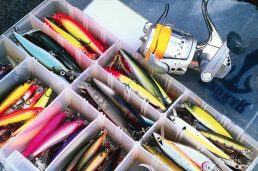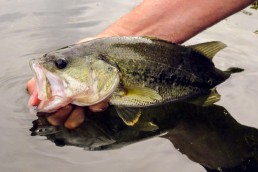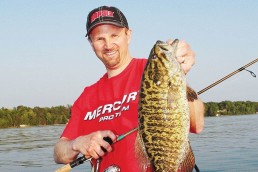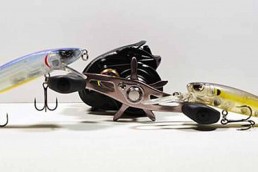Early Season Stickbait Strategies for Bass
SHARE THIS POST
Let’s talk about early-season bass strategies, mainly targeting bass during the early spring with stickbaits (a.k.a. jerkbaits).
Stickbait bass
When you look at fishing stickbaits for bass, you have to take a look at what your options are, as not all stickbaits are created equal. You have a bunch of hard bait companies that are now in the stickbait business.
As a customer, this can be good and bad all at the same time. The biggest reason is the high cost of some of the baits on the market. I myself have a hard time paying the upper echelon costs of some of these baits, as I well know that we not only have bass to contend with going after our stickbaits in my waters. You will have to watch for pike or muskies at the same time, and in that case, your bait may be there one second, then gone the next. If you try to fish the bait with a pike-proof leader (as much as I would like), that will take away all the action that the bait has, leaving you to play the game and pick and choose your battles when fishing sticks in our waters.
I stock a few different sticks in my stickbait box that give me the opportunity to show the bass a few different looks when the time calls for it. I will stock deeper baits for when the bass are making their way up out of deeper waters on some of their first trips and the water temps may still be on the cooler side. In this case, I will use either a Strike King 300 Deep or a Rapala Shadow Rap Deep. These baits are both deeper divers but have a different action when fished.
When it comes to fishing these deeper baits, I have learned that you do not want to give these baits a lot of action. Remember, you are targeting bass in deeper water. At this time of the season, bass will not be that active or aggressive, so this must reflect in how you are fishing your deeper water stickbaits.
As the water warms and the bass get more active, it is time to make a stickbait switch. I will use a few different baits, as they all have a little different action and fishability. The best way to figure this out is to spend a day on the water and just fish baits to see what they can do in the water. I do a lot of this by just tying on a bait and making a short cast close to the boat. But first, I will usually just drop the bait alongside the boat to see what it does.
Does the bait sit level in the water? Does it sink? When paused, will it stay at the same depth, or will it sink or rise in the water? All these things are key in knowing how to pick the right stickbait for the situation, and if I need to make any changes to that bait, or switch to a different bait.
Stickbait tweaks
Through the years, a few stickbait tweaks have stuck out. The biggest one has to do with changing hook sizes to get the bait to react. If you needed your stickbait to get down a foot deeper, this is many times able to be achieved by changing your hook size up one size. You start with the middle hook (if fishing a stickbait with three hooks, or the front hook if it has two hooks). This will generally be enough weight to get the stickbait to get down one more foot in the mix. If after a closer look it is not getting deep enough, you could up size another hook until you get to the depth that you were trying to reach.
In cases when I could not get the stickbait deep enough after hook changes, or if I was looking for a shortcut, I would turn to using adhesive Storm Suspend Dots or Strips. These weigh more than a hook change and were what I would turn towards if I needed more than a foot of depth change. You can also throw strips into the mix if you are looking for a greater depth.
When using the strips or the dots, make sure you put them in the middle of the belly to keep the bait level in the water. If the bait is nose-up or nose-down, it will not look natural to the bass, and many times they will not hit the bait. So, drop the bait alongside the boat and see how it sits in the water. If it’s not level, make adjustments to get it there before you start fishing.
Are you enjoying this post?
You can be among the first to get the latest info on where to go, what to use and how to use it!
If you need to go the other way and keep your bait shallower by, let’s say a foot, you need to go to smaller hooks (by 1 size) to shed the weight that was keeping the bait deeper. Once again, you will have to see how the bait reacts alongside the boat after the hook adjustment. If I have strips or dots on the bait, I will pull these off before I see how the baits act. This will give me a point in which to start with my hook choices.
In the last few years, line has made the biggest impact on fishing sticks. The die-hard masters of stickbaits at first would not throw their baits on a fluorocarbon line choice. I can clearly remember some saying that a fluorocarbon line choice would make their stickbaits sink. That was why the stickmaster himself, Mike McClelland, did not endorse a fluorocarbon line choice at first. After getting used to this new line, Mike made the choice and is now fishing most of his McSticks on Sunline SniperFC, and will have a backup of Sunline Super Natural Mono when and if he thinks it is needed.
One more note to make here: Early in the spring season, I will many times use my crankbait reels to start as the water is cold, and I do not want to fish my stickbaits on a fast-retrieve reel. I want to keep my line pickup speed on the slower side, instead of the faster side, in the early part of the season.
How to fish sticks early in the season
When it comes to fishing a stickbait in the early season, you have to get a tell-tale of how the bass want the bait fished. A lot of this will depend on time of the early season. Is it one of the very few first times that the bass are starting to come shallow? Are you on the second or third day of a warming trend? These are things that you will need to figure out as to the bass’ mood, as that will change when it comes to biting a stickbait. The best advice that I can give you is to start slow and pick up from there as you move forward.
What I am trying to say here is, at first, give your sticks a few pulls and a few twitches, but pay close attention as to when the bites are coming. Are they coming at the end of your pulls, or at the end of twitches? This will help you key in on what the bass want that day. This could change from day to day or even hour to hour as the day goes on. Pay special attention as to how the bass react to the bait and how they bite your bait. You will put more fish in your boat by paying attention to your bites.
I hope this helps you get a start on your early bass season this year. Stickbaits are great choices when looking for early-season bass, especially when they are making some of their first moves towards the shallows. Fish slowly, but also pay attention as to how you are fishing your stickbaits when you are triggering bites. This will help you put more bass in the boat. Make adjustments when needed.
To learn more about fishing jerkbaits check out our video from Mille Lacs here.
Become a Midwest Insider Here!
MWO
SHARE THIS POST
Did you enjoy this post?
You can be among the first to get the latest info on where to go, what to use and how to use it!
Scott Petersen
Scott Petersen has been writing for the past 30 years. A Minnesota native, he has a passion to fish all seasons on ice and open water. “One of my main goals is to teach people how to fish through my articles and sport-show seminars.”



